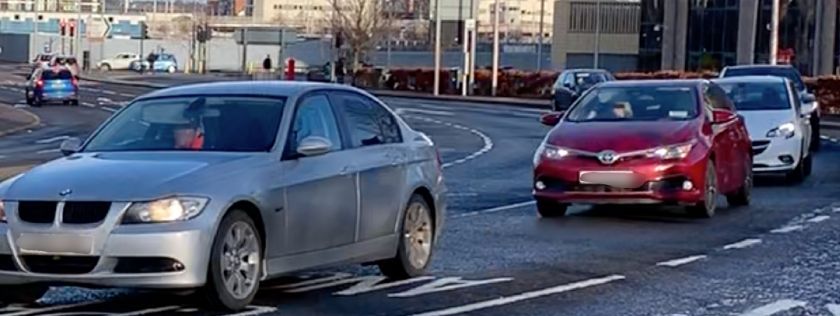Rear end shunts – who is at fault?

If another driver causes their vehicle to collide with the rear of yours, there is a fault on their part.
What is a Rear-End Shunt?
A rear-end shunt, also known as being rear-ended, is when one vehicle crashes into the back of a vehicle in front. Accidents like these frequently occur at junctions, roundabouts or when congested traffic is moving in a stop-start manner.
According to research, rear-end shunts are the most common car accident type making up almost 25% of road traffic accident cases.
In some cases, a rear-end shunt can be so severe that it pushes the vehicle in front forwards – which in turn causes that vehicle to hit someone else. This risk of multi-vehicle collisions – with multi-person casualties – is why Digby Brown believes rear-end shunts are more serious than many people appreciate.
Who is at fault?
Rule 126 of the Highway Code – the section that relates to stopping distances and tail-gating (which is where people drive too closely to the vehicle in front) - states:
“Leave enough space between you and the vehicle in front so that you can pull up safely if it suddenly slows down or stops.
“Allow at least a two-second gap between you and the vehicle in front on high-speed roads and in tunnels where visibility is reduced. The gap should be at least doubled on wet roads and up to ten times greater on icy roads.
“Remember, large vehicles and motorcycles need a greater distance to stop. If driving a large vehicle in a tunnel, you should allow a four-second gap between you and the vehicle in front.”In a case involving a rear-end shunt, there is often a presumption of fault on the driver at the rear. However, it’s not always this straightforward – especially when accusations are made that the collision happened because the car in front braked suddenly and for ‘no apparent reason’ to the rear driver.
Helping prove who is at fault in a rear-end shunt
It is important to know what to do if you have been involved in a rear-end shunt so you can secure important evidence at the moment that could prove vital later on in the event of a personal injury claim.
- Videos and photographs of the accident scene
Try to obtain video and photographic evidence of the scene. Not just with vehicle damage. Try and capture evidence of who was driving, whether they had passengers, the road conditions, the flow of traffic or the road layout.
- Witnesses to the road traffic crash
If there are any witnesses to your accident, make sure to note their details and call the police to ensure they have a record of your version of events.
- Report to the insurance company
It is important you accurately report the accident to your car insurance company even if the accident wasn’t your fault, in case a fictitious claim is made against you.
The record of the call can be recovered at a later date.
- Notifying medical staff and your employer
If the rear-end shunt leaves you with injuries that require medical help – such as a visit to A&E – then give as much detail as you can to the medical staff. This is yet more evidence that could prove helpful in the future. If you were driving in the course of your work then it’s also important to notify your employer – they may wish to make a report of this especially if it involved a company vehicle.
- Written exchanges with the other driver
If you have any correspondence from the other driver admitting liability, such as emails or text messages, make sure to keep these. It is essential that you preserve any evidence which will help you establish a fault at a later date. There may be a presumption that the driver of the vehicle who struck you was responsible for the accident but it is up to you to prove it.
Did you know?
The idea that someone is automatically and entirely to blame if they rear-end the vehicle in front is false.
Blame – or liability – for rear-end collisions depends entirely on the unique circumstances of each incident.
For example:
- Did someone stop for no reason?
- Did the weather play a factor?
- Was there a mechanical fault in either car?
Rear-ended accidents might seem straight-forward, but they rarely are – that’s why, if you’re hurt in such an accident you need a specialist solicitor.
What are the leading causes of rear-end shunts?
The most common cause of rear-end collisions is human error and driver negligence with common causes such as:
- Distracted driving
- Driving when tired
- Speeding
- Tailgating or following too closely
- Aggressive driving and road rage
- Not driving according to road conditions
- Improper maintenance of your car
- Low sun or sun glare
What types of injuries are caused by rear-end shunts?
Knowing what injuries could be caused by an accident is never straightforward as the severity of injuries depends on a number of factors such as road conditions, the size of vehicles involved and the speed of impact. However, neck, back, head and brain, and facial injuries are commonly associated with a rear-end shunt and can require intensive, long-term treatment. In some cases, these injuries can permanently impact a victim’s life.
Contact us if you’ve been involved in a rear-end shunt
If you have been injured in an accident that wasn’t your fault and you would like more information, please get in touch with one of our road traffic solicitors.

Darrell Kaye, Partner
Ayr office
